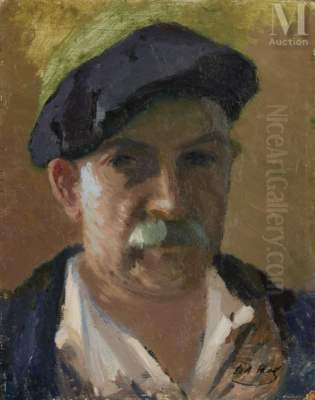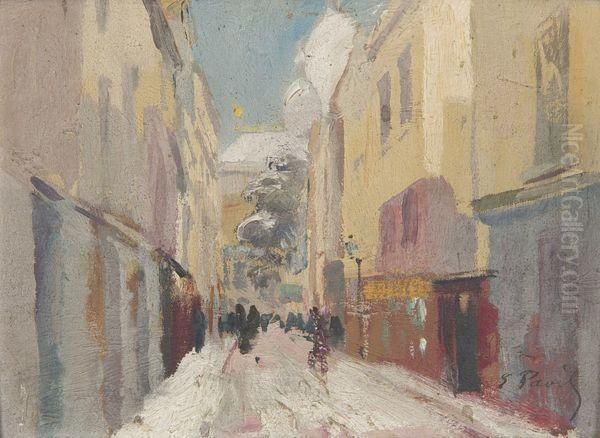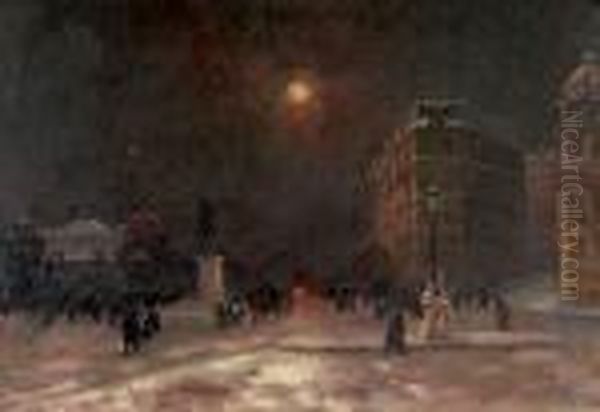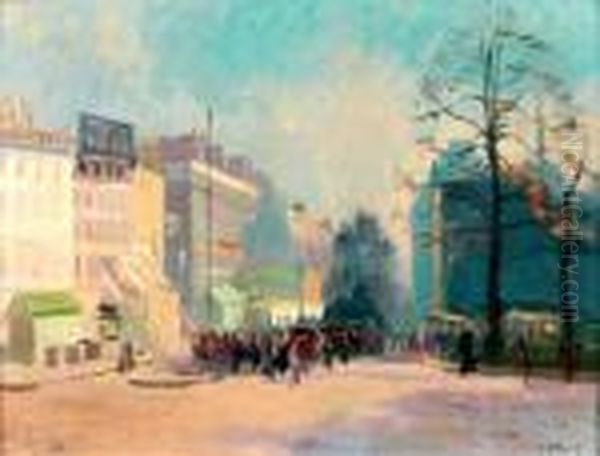
Elie Anatole Pavil (1873-1948) stands as a significant figure in French art history, an artist whose canvases captured the ephemeral beauty and vibrant energy of Paris during a period of profound cultural transformation. Born in Odessa, Ukraine, in 1873, Pavil became a naturalized French painter, deeply immersing himself in the artistic currents of his adopted homeland. His work, primarily associated with Impressionism and Post-Impressionism, yet touched by emerging modern sensibilities, offers a unique and enduring perspective on the city he called home.
Pavil's artistic journey led him to Paris in 1892, a city then pulsating as the undisputed center of the Western art world. Seeking formal training, he enrolled at the prestigious Académie Julian. This renowned private art school served as a vital alternative to the more rigid, state-run École des Beaux-Arts, attracting a diverse international student body and notable figures who sought a less conventional path. Studying at the Académie Julian placed Pavil within a dynamic environment where new ideas were debated and artistic boundaries were constantly being pushed.
Formative Years and Artistic Influences
The Paris that greeted Pavil was still reverberating with the impact of Impressionism. The revolutionary movement, championed by artists like Claude Monet, Camille Pissarro, and Auguste Renoir, had fundamentally altered the perception and depiction of reality. Their emphasis on capturing fleeting moments, the effects of light and atmosphere, and painting en plein air (outdoors) had opened new possibilities for artistic expression. Pavil absorbed these lessons, adopting the Impressionist fascination with light and color.
However, Pavil's work evolved beyond strict Impressionist tenets. He integrated elements associated with Post-Impressionism, a broad term encompassing the diverse styles that emerged in the wake of Impressionism. Artists such as Paul Cézanne, Vincent van Gogh, and Paul Gauguin sought to imbue their work with greater structure, emotional intensity, or symbolic meaning. Pavil's paintings often exhibit a more solid sense of form and composition than found in purely Impressionist works, combined with a deeply personal, often poetic, response to his subjects.

His brushwork, while often lively and suggestive, could also be more controlled, defining shapes and structures within the play of light. His palette, though rich and sensitive to atmospheric nuance, was carefully modulated to convey specific moods and times of day. He demonstrated a particular skill in rendering the unique light of Paris – the soft glow of gas lamps on wet streets, the crisp clarity of a winter morning along the Seine, or the hazy sunshine filtering through the trees in the Tuileries Garden.
Paris as Muse: Montmartre and the Cityscape
Like many artists of his generation, Pavil found endless inspiration in the streets, squares, and riverbanks of Paris. He developed a particular affinity for Montmartre, the hilltop neighborhood renowned for its bohemian atmosphere, bustling cabarets, and thriving artist community. During the late 19th and early 20th centuries, Montmartre was a crucible of creativity, home to studios like the famous Bateau-Lavoir and frequented by artists ranging from the established Edgar Degas to the iconic chronicler of its nightlife, Henri de Toulouse-Lautrec, and later, emerging figures like Pablo Picasso and Georges Braque.
Pavil captured the spirit of Montmartre in numerous canvases. His work Montmartre, rue de l'Abreuvoir (1906) is a prime example, depicting one of the charming, winding streets of the district. The painting likely conveys the unique blend of urban grit and picturesque charm that characterized the area, rendered with his characteristic sensitivity to light and atmosphere. Another work simply titled Montmartre (1905), an oil painting measuring 50 x 65 cm, further attests to his focus on this vibrant quarter, though specific details of its subject matter require further research.
His gaze extended beyond Montmartre to encompass the broader Parisian landscape. He painted views of the Seine, capturing the reflections on the water and the activity along its banks, as seen in Rue de Seine, Winter. This work likely evokes the specific melancholic beauty of Paris under a blanket of snow or in the subdued light of the colder months. He depicted famous landmarks and public spaces, such as the Place d'Iéna and the Tuileries Garden in Les Tuileries, showcasing his ability to translate grand urban vistas into intimate, atmospheric scenes. Works like Rue animée à Paris (Busy Street in Paris) demonstrate his interest in capturing the dynamism and energy of everyday city life.
Themes and Subjects: Beyond the Urban Landscape

While Paris remained his central theme, Pavil's oeuvre included other subjects. The mention of Nu assis (Seated Nude) from 1906 indicates his engagement with the figure, a traditional subject revisited and reinterpreted by modern artists. Nude studies allowed artists to explore form, line, and the play of light on the human body, moving beyond academic convention towards more personal expression. Without viewing the specific work, one can imagine Pavil approaching the subject with the same sensitivity to light and form seen in his landscapes.
The provided information also notes his depiction of Moroccan landscapes. This suggests travels outside France, likely undertaken in search of new motifs, colors, and light conditions. North Africa held a strong allure for European artists since the early 19th century, famously inspiring Eugène Delacroix. Later artists, including Henri Matisse, were drawn to the intense light and vibrant culture of Morocco. Pavil's Moroccan scenes would likely reflect this fascination, possibly showcasing a brighter palette and different atmospheric effects compared to his Parisian views.
His work La bouquiniste à Montmartre (The Bookseller in Montmartre) points to another facet of Parisian life he captured – the small details and everyday characters that contribute to the city's unique fabric. The riverside booksellers (bouquinistes) are an iconic part of the Parisian scene, and a painting focused on one suggests an intimate, observational approach, celebrating the quiet moments within the bustling metropolis.
Patronage and Recognition: The Role of Charles Ephrussi
An artist's career often depends on support and recognition, and Pavil benefited significantly from his connection with Charles Ephrussi (1849-1905). Ephrussi was a highly influential figure in the Parisian art world – a wealthy historian, critic, collector, and prominent member of the Jewish banking Ephrussi family. He was an editor and contributor to the prestigious Gazette des Beaux-Arts and an early, discerning supporter of the Impressionists, building a notable collection that included works by Monet, Degas, Renoir, and Berthe Morisot.
Ephrussi recognized the talent of the young Pavil, described in one source as a "young Russian artist" (though Ukrainian-born and later French, his Eastern European origins were noted). Ephrussi provided crucial support, offering Pavil his first commissions, organizing exhibitions of his work, and purchasing paintings. This patronage was invaluable, helping Pavil gain visibility and establish his reputation in the competitive Parisian art scene. Ephrussi's own cultural significance is further highlighted by his status as one of the models for the character Charles Swann in Marcel Proust's monumental novel In Search of Lost Time.

Pavil's growing recognition was also reflected in his participation in major juried exhibitions. He regularly showed his work at the Salon d'Automne and the Salon des Artistes Français. The Salon d'Automne, established in 1903, was particularly important as a venue for more progressive art, famously hosting the scandalous debut of the Fauves (including Matisse) in 1905. The Salon des Artistes Français represented a more established, though still significant, platform. Exhibiting at these Salons placed Pavil's work before a wide audience of critics, collectors, and the public.
Market Presence and Artistic Standing
The enduring appeal of Pavil's work is evident in its continued presence in the art market. Auction estimates mentioned for Montmartre, rue de l'Abreuvoir (€2000-€3000) and Nu assis (€1000-€1500), while specific to a particular sale, indicate a consistent level of collector interest. The fact that several of his key works, such as Place d'Iéna, Rue de Seine, Winter, Rue animée à Paris, Les Tuileries, and La bouquiniste à Montmartre, reside in private collections further underscores their desirability.
Pavil navigated the complex artistic landscape of the late 19th and early 20th centuries, a period marked by rapid stylistic innovation and intense artistic dialogues. While the provided information suggests no documented evidence of direct collaboration or intense rivalry with specific contemporaries – unlike the famous competitive dynamic between Picasso and Matisse, or historical precedents like the Renaissance rivalry between Michelangelo and Raphael – Pavil was undoubtedly aware of and working alongside a multitude of talented artists.
His focus on intimate Parisian scenes finds parallels in the work of Nabis painters like Pierre Bonnard and Édouard Vuillard, though Pavil's style remained more rooted in Impressionist observation of light. His cityscapes can be considered alongside those of Albert Marquet, who also specialized in views of Paris and the Seine, often employing a simplified, atmospheric style. Pavil carved his own niche, blending Impressionist sensitivity with a Post-Impressionist structure and a distinctly poetic sensibility.
Legacy and Conclusion
Elie Anatole Pavil died in 1948, leaving behind a substantial body of work that serves as a luminous record of Paris during the Belle Époque and the early decades of the 20th century. He was more than just a topographical painter; he was an interpreter of the city's moods, its light, and the lives unfolding within its streets and squares. His paintings capture the transformation of urban life, the interplay of nature and architecture, and the fleeting moments of beauty found in the everyday.

His artistic style, a nuanced fusion of Impressionist technique and modern feeling, gives his work a timeless quality. He successfully balanced observation with personal expression, creating canvases that are both visually engaging and emotionally resonant. He captured the specific atmosphere of Paris – its elegance, its energy, its occasional melancholy – with a skill and sensitivity that continues to attract art lovers and collectors.
While perhaps not as revolutionary as some of his contemporaries, Elie Anatole Pavil holds an important place in the narrative of French painting. He represents a significant strand of artists who absorbed the lessons of Impressionism and adapted them to create a personal vision, deeply connected to the places they depicted. His dedication to capturing the light and life of Paris ensures his enduring legacy as a poetic chronicler of the city he loved. His works remain a testament to his skill and a valuable window onto a bygone era.